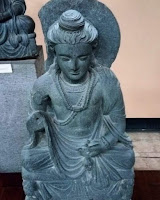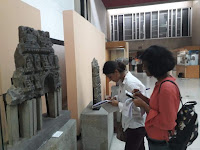Speaking Archaeologically workshop on Buddhist art and Archaeology – 5th August, 2018
“The past is a foreign country and art is the passport to it.” - Anonymous
If my life could be a testament to anything it would
probably be to the fact that staying up post three scrolling through Instagram
while sipping on your second cup of espresso can land you in the most
unexpected of places; sometimes ,even the right places. Now don’t get me wrong
, I don’t mean to recommend such unhealthy behavior to anyone reading this but
that is how I came across ‘Speaking Archaeologically’s’ Instagram handle some three months ago. Needless to say it wasn't long before I fell in love with history all over again and decided this organisation was something I wanted to be a part of . What followed that was me applying the famed and oft used three fold Bollywood strategy to get anything you want in life, which in this case included religiously stalking the Instagram page for recruitment posters or declarations, working hard to prove I’m worthy by sending in submissions and finally, Shriya replying to my over the top enthusiastic emails and taking me in. Now
when I look back I can say with pride that like all great love stories mine
started with a DM and a follow. Only my love story
with history hasn’t reached its very end and with everything we do at speaking
archaeologically it only grows every day.
So post our recruitment session when we were called
in for our first workshop at the Government Museum and Art Gallery in Sector 10
Chandigarh, I was beyond excited. We were greeted at the venue by Shriya who
made it a point to flash a genuine smile the moment she saw any of us enter. The
air was filled with anticipation and eagerness for the new minds like me stood visibly beguiled trying
to take in the space looking around with rat eyes at all the sculptures , while
the old ones, our seniors stood in the background looking at us with curiosity trying to
compare and picture themselves from when they
had come for their first workshop .Once everyone arrived, Shriya started
with introducing the topic for the
session which was followed by the
process of deconstructing ideas ,preconceived notions and dispelling myths
through a friendly interaction. We were explained the concept of sculptures-the
different types: broadly relief and free standing, the distinguishing features
of the various schools of art to which the Buddhist sculptures belonged mainly
the Gandhara and Mathura schools of art, briefly explained the importance of a
provenance while looking at ancient objects and were provided with an understanding
of how to analyze every visible detail so as to construct a history of the object.
 |
| Sculpture of Maitreya, Gandhara School of Art (Late 2nd century CE) |
We were given worksheets for object analysis and a
handout to refer to for instructions and information related to the same. We were
then divided into teams in a way that saw the coming together of people from
different academic disciplines and from different batches at Speaking Archaeologically,
some sort of ice-breaking session as it was claimed to be, the idea of which
itself is enough to give you a panic attack if you like me faked a sore throat every
time the teacher asked you to introduce yourself to the class. So if you’ve ever wondered what it’s like to
witness a discussion between archaeology, anthropology, history and law
students who have been put together in one team I’m here to tell you that it’s
no different from watching a political debate on any Indian news channel. My
team which comprised of Mayank, Vidushi , Muskan and I walked around the museum
with our worksheets trying to find the most interesting sculptures to analyze …or
should I say the easiest ones. Each one of us was asked to pick any five
Buddhist sculptures and instructed to be as concise in our descriptions as
possible.
 Safe to say that
one hour out of two was spent taking pictures of and staring at the sculptures
in hopeless despair wishing they would magically come alive and tell
us everything we needed to know about their history. And so while the newbie’s
like me in every team stood in front of the sculptures looking visibly
perplexed it wasn’t long until the seniors in our teams stepped in and decided
to bless us with their insights to build on from whatever they had learned in
their years at Speaking Archaeologically. Shriya, with her endless amount of
knowledge, using more wit and charm than the law allows kept interacting and checking
up on us every once in a while to keep us from crying at our lack of
cognizance. Thus we toiled for another one hour with our brain cells working in
high gear, noting down in the columns of the worksheets any details that could
be noticed in an effort to study and come up with answers regarding things like
the original resting place of the sculpture, the material used, the school of
art based on our observations and through them to deduce a basic understanding
of the sculpture, its patron and people and the economy of the time.
Safe to say that
one hour out of two was spent taking pictures of and staring at the sculptures
in hopeless despair wishing they would magically come alive and tell
us everything we needed to know about their history. And so while the newbie’s
like me in every team stood in front of the sculptures looking visibly
perplexed it wasn’t long until the seniors in our teams stepped in and decided
to bless us with their insights to build on from whatever they had learned in
their years at Speaking Archaeologically. Shriya, with her endless amount of
knowledge, using more wit and charm than the law allows kept interacting and checking
up on us every once in a while to keep us from crying at our lack of
cognizance. Thus we toiled for another one hour with our brain cells working in
high gear, noting down in the columns of the worksheets any details that could
be noticed in an effort to study and come up with answers regarding things like
the original resting place of the sculpture, the material used, the school of
art based on our observations and through them to deduce a basic understanding
of the sculpture, its patron and people and the economy of the time.
Once confident about our observation sheets we took them
to Shriya for evaluation who patiently corrected our mistakes and patted our
backs for a job well done. And even though my team didn’t get the highest score
that day we made it a point to congratulate the team that did .Thus, with new perspectives gained we headed for the one thing
everyone at Speaking Archaeologically looks forward to post a good workshop –
Food. And so while everyone sat down
for lunch all giggly and amused, I couldn’t help but wonder how beautiful it is
that in archaeology even the most minute details like the draping of a cloth as
depicted in a sculpture, the quality of the material used etc. can provide deep
rooted insights into the life, trade and culture of the time. It is only through
careful evaluation of ancient objects like sculptures that we get an insight
into the creative capacities of the generations gone by, the socio-economic and
political conditions of the time, the prevailing customs and beliefs and are
able to trace their origins and impact in the vast expanse of time. Thus,
archaeology if not the biggest serves as a medium to appreciate the beauty of
artistic expression.







Comments
Post a Comment